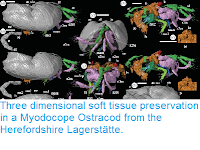Ostracods are small bivalved Crustaceans that live in various aquatic environments including freshwater and marine habitats ranging from the supralittoral zone to the hadal zone. A number of ostracods are also known to be symbiotic with Invertebrates and Vertebrates. The Polycopid Ostracod genus Pontopolycope is characterized by a fully developed rostrum and concavity immediately ventral to the rostrum on the anterior margin of the carapace. This is a special characteristic of the family Polycopidae. To date, all four living congeners have been described from the Atlantic: Pontopolycope rostrata, Pontopolycope dentata, Pontopolycope mylax, and Pontopolycope storthynx.
In a paper published in the journal Zoological Studies on 20 April 2020, Hayato Tanaka of the Tokyo Sea Life Park, and Yusuke Kondo and Susumu Ohtsuka of the Setouchi Field Science Center of Hiroshima University, describe the first living representative of the genus Pontopolycope from the Indo-Pacific region.
Sediment samples were obtained from the sandy bottom at 52 m depth off the Nagannu Island, Okinawa Prefecture, southwestern Japan, on May 21, 2016, by using a dredge (mouth 50 cm wide × 15 cm high; mesh size 5 mm) towed along the bottom twice by the TRV Toyoshio-maru (Hiroshima University). Sediments were stirred in seawater, and the supernatant was filtered with a small plankton net (mesh size 0.1 mm). All living ostracod specimens were extracted from the remaining deposits under a binocular stereomicroscope.
Map showing the sampling site. (A) Japan; (B) sampling locality. Tanaka et al. (2020).
The new species is named Pontopolycope orientalis, where 'orientalis' is Latin for 'in the east', in reference to the fact that this is the living species of the genus Pontopolycope in the Indo-Pacific region. The species is described from ten specimens, six males and four females.
The carapace of Pontopolycope orientalis is circular in lateral view, with developed rostrum and concavity immediately ventral to the rostrum of anterior margin. The posterior end is situated slightly near to the ventral side. The surface of the carapace is covered with shallow pits. Along anterior to posterior margin of the left valve and anterior to ventral margin of the right valve are a series of serrations. There is a pore system consisting of a shallow depression and a small dome with pore a canal. The adductor muscle scar consists of three closely spaced scars. A marginal infold with groove runs around the internal marginal zone of the postero-dorsal, anterior and ventral margins in the right valve; there is a corresponding ridge in the left valve. The hinge structure consists of a simple groove in the right valve and of a corresponding bar in the left valve.
Pontopolycope orientalis, scanning electron microscope images. (A), (B), (G), paratype male (NSMT-Cr 27374); (C), (D), (H), paratype male (NSMT-Cr 27375); (E), (F), paratype female (NSMT-Cr 27379). (A), (E), external lateral view of right valve; (B), (F), external lateral view of left valve; (C), internal lateral view of right valve; (D) internal lateral view of left valve; (G) external surface of left valve; (H) adductor muscle scar, internal view of right valve. Scale bars: (A)–(F) 100 μm; (G) 15 μm; (H) 30 μm. Tanaka et al. (2020).
See also...
Follow Sciency Thoughts on Facebook.








